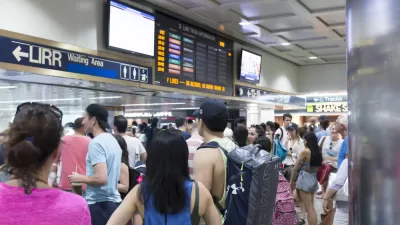New Jersey Transit has broken ground on what may be the nation's most costly transit project: a commuter rail tunnel under the Hudson River to a new Penn Station Expansion that, to the chagrin of transit advocates, will not connect to Penn Station.
"A ceremonial groundbreaking was set for (June 8) in North Bergen, N.J., the site of the first small piece of what could be the biggest transit project in the country.
The Mass Transit Tunnel - formerly known as the Trans-Hudson Express and, before that, Access to the Region's Core - more than 15 years after it was conceived is expected to take eight years to complete, bears a current price tag of $8.7 billion. That is about $6 billion less than the so-called Big Dig highway tunnel in Boston cost but about $6 billion more than the project's original price.
The Hudson tunnel was designed to help ease the jam-packed rides that rail commuters from the west have long endured. New Jersey Transit, which runs as many as 23 trains an hour through a century-old tunnel into Pennsylvania Station in New York, has said that it is nearing maximum capacity. The riders of those trains share Penn Station with passengers of the Long Island Rail Road and Amtrak.
That tunnel would bring trains from the suburbs of North Jersey and would end in a bilevel station to be built about 180 feet below 34th Street between Sixth and Eighth Avenues.
That station, dubbed the Penn Station Expansion, was originally designed to connect to Penn Station so that Amtrak and New Jersey Transit would have another route in and out of New York. But the project's planners threw out that idea when they decided that they needed to cut much deeper under the city.
Some mass transit advocates have insisted that the tunnel connect to either Penn Station or Grand Central Terminal, or both, to be useful to many of the commuters. Others have argued that the proposed station, 18 stories below ground, will be too difficult to evacuate in a fire or other emergency."
Thanks to Bay Area Transportation News
FULL STORY: Groundbreaking Set for New Jersey Transit Tunnel Under Hudson

Trump Administration Could Effectively End Housing Voucher Program
Federal officials are eyeing major cuts to the Section 8 program that helps millions of low-income households pay rent.

Planetizen Federal Action Tracker
A weekly monitor of how Trump’s orders and actions are impacting planners and planning in America.

Ken Jennings Launches Transit Web Series
The Jeopardy champ wants you to ride public transit.

Crime Continues to Drop on Philly, San Francisco Transit Systems
SEPTA and BART both saw significant declines in violent crime in the first quarter of 2025.

How South LA Green Spaces Power Community Health and Hope
Green spaces like South L.A. Wetlands Park are helping South Los Angeles residents promote healthy lifestyles, build community, and advocate for improvements that reflect local needs in historically underserved neighborhoods.

Sacramento Plans ‘Quick-Build’ Road Safety Projects
The city wants to accelerate small-scale safety improvements that use low-cost equipment to make an impact at dangerous intersections.
Urban Design for Planners 1: Software Tools
This six-course series explores essential urban design concepts using open source software and equips planners with the tools they need to participate fully in the urban design process.
Planning for Universal Design
Learn the tools for implementing Universal Design in planning regulations.
Heyer Gruel & Associates PA
Ada County Highway District
Institute for Housing and Urban Development Studies (IHS)
City of Grandview
Harvard GSD Executive Education
Toledo-Lucas County Plan Commissions
Salt Lake City
NYU Wagner Graduate School of Public Service




























